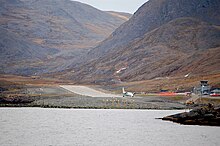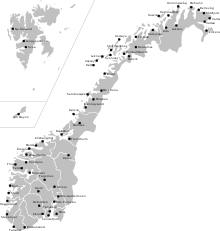List of airports in Norway

Norway has 98 airports which are certified or have been designated an International Civil Aviation Organization airport code (ICAO code).[1] Forty-eight airports facilitate public flights, including one heliport, Værøy Heliport.[2] Forty-five of these are owned by the government through its airport operator, Avinor. Scheduled airports are grouped into primary airports, which are sufficiently large to serve jetliners, and regional airports, which can only handle regional aircraft.[3]
The airports used only for general aviation (GA) are owned by a mix of municipalities, aviation clubs and private companies.[4] The latter include some which are controlled by the state or municipalities. Two are owned by the Norwegian Armed Forces.[5][6] The Royal Norwegian Air Force has ten air stations which are co-located with primary airports ("joint" airports).

Oslo Airport, Gardermoen is by a factor of almost four the busiest airport in the country, about half of which is international services.[2] It opened in 1998—replacing Oslo Airport, Fornebu—[7] and serves as a hub for Norwegian Air Shuttle and Scandinavian Airlines (SAS).[8] It is followed by three other major airports, Bergen Airport, Flesland; Stavanger Airport; and Trondheim Airport, Værnes.[2] These act as focus cities for said airlines. The four next airports are of almost equal size.[2] Sandefjord Airport, Torp serves low-cost airlines in Eastern Norway and is often branded as "Oslo" by airlines such as Ryanair.[9] Bodø Airport and Tromsø Airport act as hubs within Northern Norway, from which Widerøe flies to regional airports. Oslo, Trondheim and Bergen have a similar function in Southern Norway.[3]

Norway is the country in Europe with the most airline trips per capita. The routes from Oslo to Trondheim, Bergen and Stavanger are all amongst the ten busiest in Europe. Contributing causes are a low population density, a rugged geography and limited population in the interior and the north, which combined have resulted in a poor road and rail infrastructure.[10] Many smaller airport have short runways which permit only fairly small aircraft on short routes. Future lack of compatible aircraft has started plans to extending some, close down some (combined with road improvement) and to replace a few with new airports.
Airports
[edit]The list includes fixed-wing airports approved by the CAA[4] and those with an ICAO code.[1][11] In addition, closed land airports are included if they were either issued ICAO codes or they served scheduled flights. Heliports are only included if they have scheduled flights and are part of the regional aviation system. Water aerodromes are excluded.
The list contains the airport name, the city served and the county in which the airport is located (which may differ from the county of the city served). The type of airport is subdivided into primary airports, regional airports (one marked as a heliport), military (used exclusively by the Norwegian Armed Forces), joint (airports with both a civilian airport and a military air base), GA (used exclusively for general aviation) and closed airports. The ownership consists of airports owned by Avinor, municipally-owned airports, airports owned by the military, those owned by aviation clubs, and privately owned through a limited company. The list further states the ICAO code[1][11] and the International Air Transport Association airport code (IATA code).[11][12] The length of the longest runway (rwy) is stated.[13] Passenger data (pax) is for 2016 and counts both boarding and disembarking passengers.[2] Airport names shown in bold indicate airports with scheduled service on commercial airlines.
Evolution in graph
[edit]Graphs are unavailable due to technical issues. There is more info on Phabricator and on MediaWiki.org. |
See also
[edit]- List of the busiest airports in the Nordic countries
- List of heliports in Norway
- Scandinavian Mountains Airport (Sälen Trysil Airport)
References
[edit]- ^ Jump up to: a b c "Location Indicators by State" (PDF). International Civil Aviation Organization. 17 September 2010. pp. 82–83.
- ^ Jump up to: a b c d e "Passenger statistics". Avinor. Retrieved 20 April 2017.
- ^ Jump up to: a b Bråthen, Svein. "Luftfartens rolle i regional samferdsel" (PDF) (in Norwegian). Avinor. Archived from the original (PDF) on 9 March 2012. Retrieved 27 July 2010.
- ^ Jump up to: a b "Liste over godkjente lufthavner og flyplasser" (in Norwegian). Civil Aviation Authority of Norway. 1 November 2013. Retrieved 16 November 2014.
- ^ Barr, Susan (1991). Jan Mayen (in Norwegian). Oslo: Schibsted. p. 245. ISBN 82-516-1353-1.
- ^ Kjeller flyplass 75 år (in Norwegian). Forsvarets forsyningskommando. 1987. p. 93.
- ^ Bredal, Dag (1998). Oslo lufthavn Gardermoen: Porten til Norge (in Norwegian). Schibsted. p. 42. ISBN 82-516-1719-7.
- ^ Kaspersen, Line (30 July 2014). "– Store muligheter for enda flere langruter". Dagens Næringsliv (in Norwegian). Retrieved 3 December 2014.
- ^ Tjomsland, Audun (2005). Høyt spill om Torp (in Norwegian). Sandefjord: Tjomsland Media. pp. 197–205. ISBN 82-997212-0-2.
- ^ Grønli, Kristin Straumsheim (7 June 2007). "Så mye flyr vi" (in Norwegian). Forskning.no. Retrieved 3 December 2014.
- ^ Jump up to: a b c "Location indicators" (PDF). Aeronautical Information Service. Avinor. 1 March 2018. Retrieved 1 March 2018.
- ^ "Code for Trade and Transport Locations – NO/Norway". United Nations Economic Commission for Europe. Retrieved 2 December 2014.
- ^ "Strategiplan flyplasser" (PDF). K. O. Sunde. Archived from the original (PDF) on 24 July 2011. Retrieved 31 August 2012.
- ^ "Passengers 2017". avinor.no. Retrieved 18 October 2023.